As you have no doubt noticed, cases of bed bug infestation are on the increase, both in our homes and in public places. With the explosion in travel, global warming and a lack of knowledge about the subject, these little blood-sucking insects have found ideal conditions for spreading. The fight against this public health problem is being organised, starting with a thorough understanding of the biology and behaviour of bed bugs. Biological characteristics, lifestyle, reproduction: here is everything you need to know about Cimex lectularius. The aim is to understand them better in order to eliminate them more effectively.
The article in brief
➡️ Cimex lectularius is the most common species of bed bug in France: a biting and sucking insect that is active at night and feeds only on human blood.
➡️ The life cycle of a bed bug includes 6 stages: egg, 5 immature stages (nymphs) and then adult. Each moult requires a blood meal.
➡️ An adult female can lay up to 500 eggs in her lifetime. The eggs are extremely resistant and very difficult to eliminate.
➡️ Bedbugs hide in dark, narrow places, as close as possible to humans: mattress seams, box springs, cracks in furniture, baseboards.
➡️ Effective treatments combine heat (dry steam), cold (-20°C for 72 hours), thorough vacuuming and application of diatomaceous earth in nooks and crannies.
The biological characteristics of bed bugs
These tiny but formidable insects have biological characteristics that explain their ability to adapt and proliferate in our homes.
According to an ANSES report, between 2017 and 2022, 11% of households in France were contaminated by bed bugs (source).
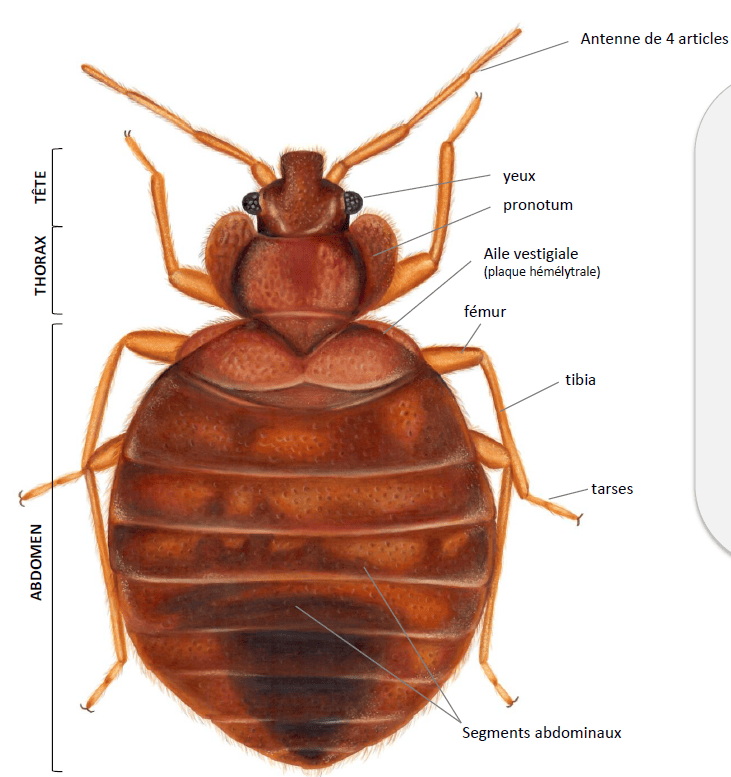
Cimex lectularius: the most common species in France
In France, the most common species of bed bugs is ‘Cimex lectularius’. For your information, there are two species on earth: ‘Cimex lectularius’ and ‘Cimex hemipterus’, which are part of the ‘Cimicinae’ subfamily.
Its main characteristics:
- Biting-sucking insect: it feeds solely on human blood to survive and develop.
- Oval, flattened body: handy for slipping into the smallest cracks, mattress seams, furniture or skirting boards.
- Adult size: apple seed.
- Nocturnal activity: bedbugs avoid light and mainly come out at night, when their host is still and asleep.
- Incapable of jumping or flying: unlike other pests, they only move by walking.
- Life expectancy: 6 to 12 months.
There are a few natural predators such as the common swift.
An insect that feeds exclusively on human blood
At each stage of its life, bed bugs need to feed on blood in order to survive.
What you need to know about their diet:
- Bed bugs must feed on blood before each moult.
- Average duration of a meal: 10 minutes.
- Time between 2 meals: 5 to 15 days.
- Both males and females bite.
- They are attracted to the CO₂ given off by our breathing and to our body odours, not directly to blood.
Good to know: Their saliva contains an anticoagulant that liquefies the blood and facilitates the meal. It also contains histamine, which is responsible for local inflammation and therefore for the appearance of the famous red spots.
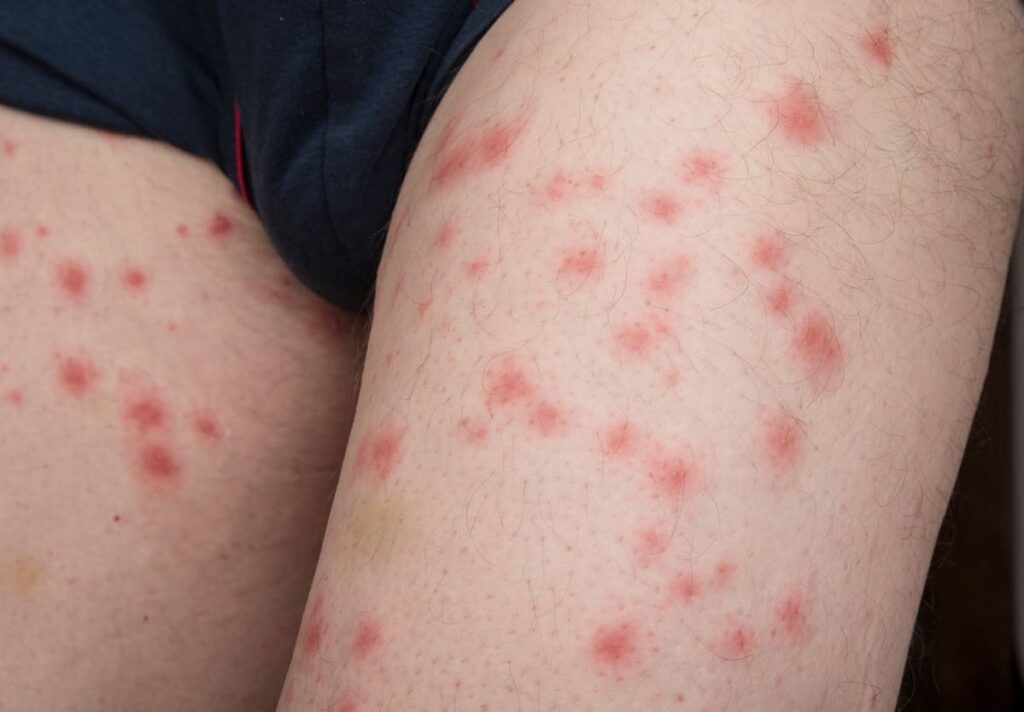

Can they bite animals?
Even though Cimex lectularius clearly prefers humans, some related species can also bite bats or birds. But in a domestic environment, bed bugs feed almost exclusively on human blood.
➡️ To find out more: What you need to know about bed bugs and pets
Life cycle of bed bugs: from eggs to adults
Like all insects, bed bugs have a life cycle consisting of several stages, from tiny eggs to adults capable of reproducing.
| Stade | Waist | Special features |
| Egg | 1 mm | Very sticky, covered with a protective waxy layer, difficult to remove. |
| Stade 1 to 5 (nymphs) | 1,5 à 4,5 mm | Need a blood meal to pass each stage. Nymphs resemble adults, but are smaller and lighter in colour. |
| Adult | 5 à 7 mm | An active reproducer, a female lays up to 500 eggs in her lifetime. |

Temperature plays a key role in the development of bed bugs. The warmer it is, the faster they develop. Conversely, low temperatures greatly slow their growth.
Key points to remember about the life cycle of bed bugs
➡️ Each adult female lays an average of 3 to 5 eggs per day.
➡️ A bed bug goes through 5 immature stages called nymphs (falsely referred to as larvae of bed bugs).
➡️ With each moult, a blood meal is essential to move on to the next stage.
➡️ The eggs are extremely resistant to conventional insecticides because of their waxy shell.
➡️ Temperatures strongly influence the speed of development:
- At 28°C: a complete cycle (egg → adult) lasts 45 days.
- At 18°C: the cycle is slowed to around 100 days.
- At 13°C: the evolution can take up to 5 months.
Lifestyle of bed bugs
Discreet, tenacious and perfectly adapted to the human environment, bed bugs develop very specific behaviours to survive and multiply.
Insects that live exclusively alongside humans
Cimex lectularius is a parasitic insect strictly linked to humans: it does not naturally live outside (except in exceptional conditions). It seeks out the proximity of a human host in order to feed on blood (it is a haematophagous insect at all stages of its life).
They are essentially nocturnal: they flee from light and mainly come out at night, when the host is immobile. When a population becomes too large, they can sometimes be seen during the day.
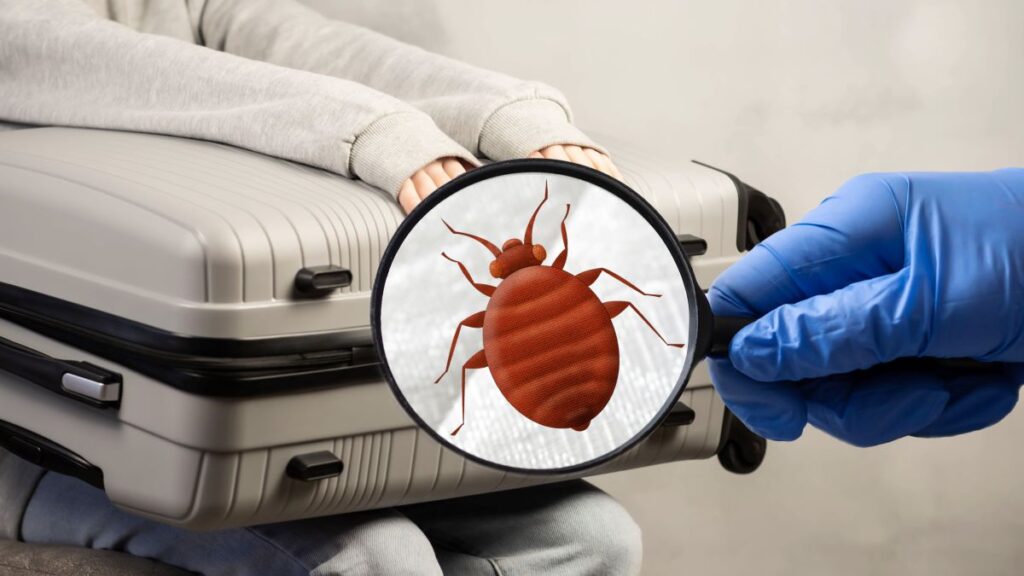
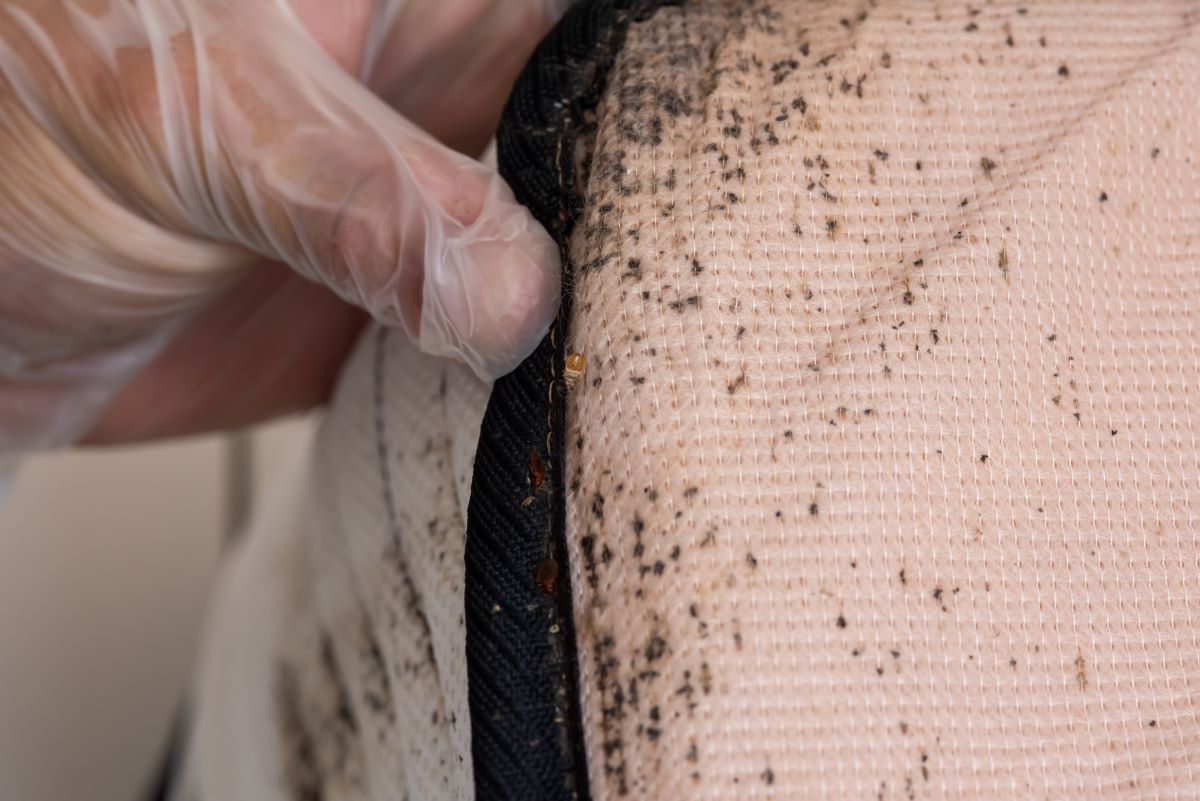
Where do bed bugs hide?
Their objective: to stay as close as possible to their food source (humans), in dark, narrow and difficult to access places.
They are mainly found:
- In clothing, curtains, bags or luggage in the event of an advanced infestation.
- In the seams of mattresses and box springs.
- Behind skirting boards, cracks in walls or furniture.
- Under bed slats, in the gaps of furniture.
- Behind headboards, frames, pictures or electrical sockets.
How do bed bugs move?
A bed bug moves quickly when walking. It does not fly or jump.
These insects can migrate from room to room through cracks, ducts, sockets or furniture.
In a building, they will move from floor to floor through pipes, electrical ducts, air conditioning systems, etc. They can also attach themselves to the clothes and other fabrics of the occupants.
Also beware of the presence of bed bugs in hotels or Airbnb accommodation.
How do they communicate?
Bed bugs use aggregation pheromones to group together in hiding places.
They are also guided by:
- The CO₂ released by human respiration.
- Body heat.
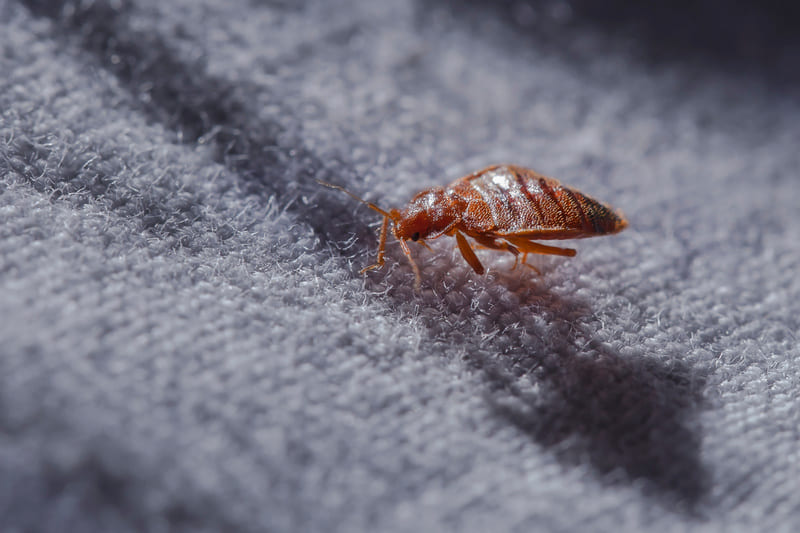
Reproduction of bed bugs
The reproductive capacity of bed bugs is one of the main reasons for their rapid proliferation. The cycle is short, there are numerous egg-laying episodes and the eggs are particularly resistant.
Female bed bugs lay up to 5 eggs a day and around 500 eggs in their lifetime.
These eggs are tiny (1 mm), white and covered with a waxy layer that makes them very difficult to remove or kill with conventional insecticides.
A specific behaviour: traumatic insemination
Bed bugs mate in a particular way. The male directly pierces the female’s abdomen to inject his sperm. This is known as traumatic insemination. This method of reproduction is extremely aggressive for the female, which explains why some of them leave the nest to form satellite colonies in other areas of the home. For information, in a population of bed bugs, there are approximately 60% males and 40% females.
Good to know: traumatic insemination circulates genetic information.
Satellite colonies: behaviour that causes massive infestations
When an infestation becomes significant, the females flee areas that are too crowded or too exposed to the males. They hide in other quieter places (distant furniture, other rooms, clothes, bags, etc.).
This is how the infestation gradually spreads throughout an entire apartment, building or even a hotel.
Effective treatment measures
When faced with an infestation of bed bugs, a partial or approximate treatment is often doomed to failure. To get rid of these insects for good, it is essential to combine several complementary techniques, following a rigorous protocol.
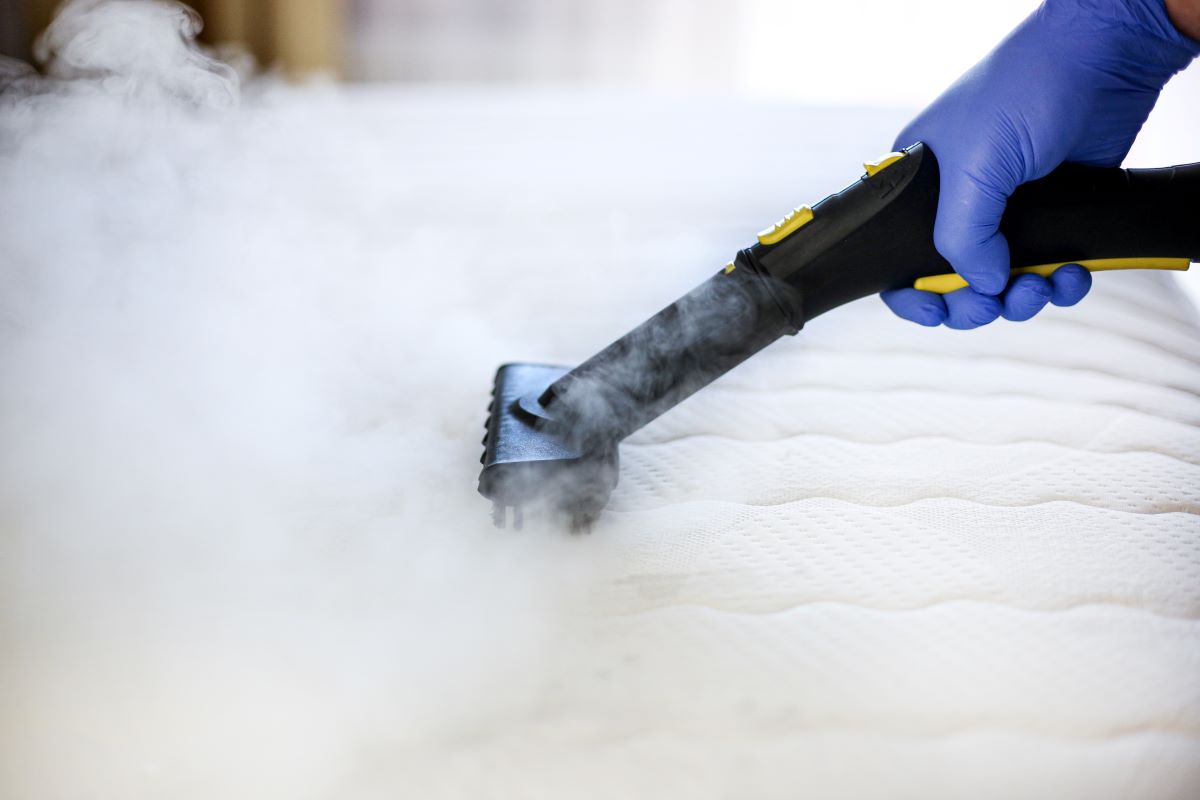
Thermal treatments: steam and cold
Extreme heat and cold are the only truly effective methods against all stages of development, including eggs.
Heat treatment
Use a dry steam cleaner (minimum 120°C). Direct contact with steam instantly kills bed bugs, larvae and eggs.
Important: steam is effective up to a maximum distance of 5 cm. Beyond that, it loses its lethal power.
Cold treatment
Place contaminated objects in the freezer at -20°C for at least 72 hours. Warning: freezing for 24 hours is not enough. Bugs can survive at -20°C if the time is too short. This type of treatment eliminates bed bugs, their larvae and their eggs.
Diatomaceous earth: a natural and long-lasting treatment
Diatomaceous earth is a mineral powder that acts by mechanical means. It kills and dries out bed bugs in 4 to 5 days.
It is particularly useful for areas that are difficult to access: behind skirting boards, in electrical sockets (only in sachets), under furniture, etc.
Good to know: clay from Somme is effective in killing bed bugs.
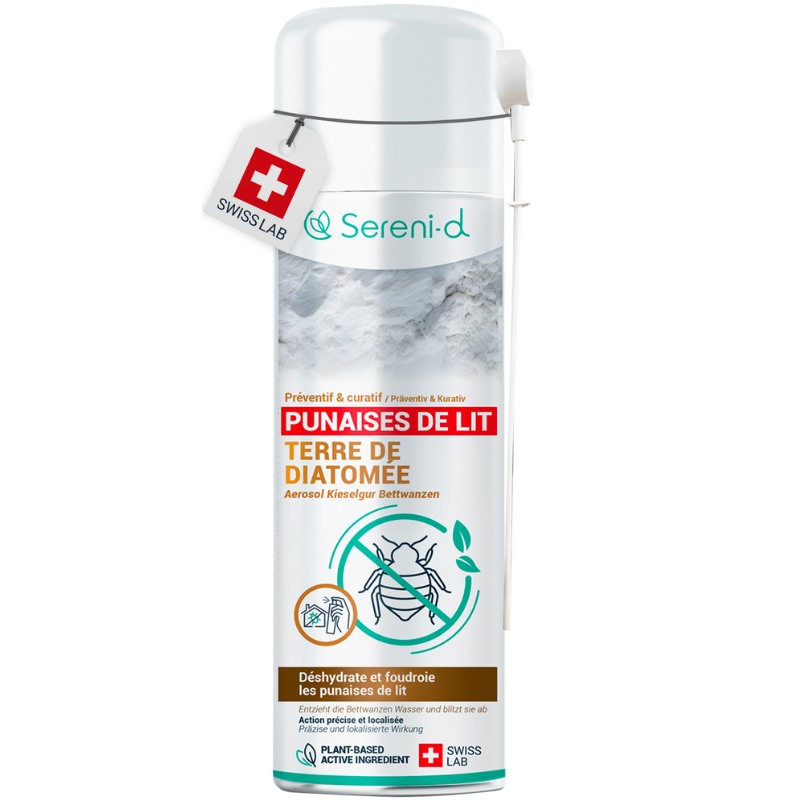

Vacuuming: an essential daily task
Vacuum thoroughly:
- Seams of mattresses and box springs
- Cracks in furniture and baseboards
- Dark corners where bed bugs like to hide
Then dispose of the contents in an airtight bag outside.
➡️ To find out more: The complete protocol for bed bug treatment.

